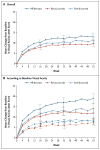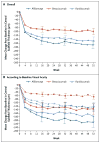Aflibercept, bevacizumab, or ranibizumab for diabetic macular edema
- PMID: 25692915
- PMCID: PMC4422053
- DOI: 10.1056/NEJMoa1414264
Aflibercept, bevacizumab, or ranibizumab for diabetic macular edema
Abstract
Background: The relative efficacy and safety of intravitreous aflibercept, bevacizumab, and ranibizumab in the treatment of diabetic macular edema are unknown.
Methods: At 89 clinical sites, we randomly assigned 660 adults (mean age, 61±10 years) with diabetic macular edema involving the macular center to receive intravitreous aflibercept at a dose of 2.0 mg (224 participants), bevacizumab at a dose of 1.25 mg (218 participants), or ranibizumab at a dose of 0.3 mg (218 participants). The study drugs were administered as often as every 4 weeks, according to a protocol-specified algorithm. The primary outcome was the mean change in visual acuity at 1 year.
Results: From baseline to 1 year, the mean visual-acuity letter score (range, 0 to 100, with higher scores indicating better visual acuity; a score of 85 is approximately 20/20) improved by 13.3 with aflibercept, by 9.7 with bevacizumab, and by 11.2 with ranibizumab. Although the improvement was greater with aflibercept than with the other two drugs (P<0.001 for aflibercept vs. bevacizumab and P=0.03 for aflibercept vs. ranibizumab), it was not clinically meaningful, because the difference was driven by the eyes with worse visual acuity at baseline (P<0.001 for interaction). When the initial visual-acuity letter score was 78 to 69 (equivalent to approximately 20/32 to 20/40) (51% of participants), the mean improvement was 8.0 with aflibercept, 7.5 with bevacizumab, and 8.3 with ranibizumab (P>0.50 for each pairwise comparison). When the initial letter score was less than 69 (approximately 20/50 or worse), the mean improvement was 18.9 with aflibercept, 11.8 with bevacizumab, and 14.2 with ranibizumab (P<0.001 for aflibercept vs. bevacizumab, P=0.003 for aflibercept vs. ranibizumab, and P=0.21 for ranibizumab vs. bevacizumab). There were no significant differences among the study groups in the rates of serious adverse events (P=0.40), hospitalization (P=0.51), death (P=0.72), or major cardiovascular events (P=0.56).
Conclusions: Intravitreous aflibercept, bevacizumab, or ranibizumab improved vision in eyes with center-involved diabetic macular edema, but the relative effect depended on baseline visual acuity. When the initial visual-acuity loss was mild, there were no apparent differences, on average, among study groups. At worse levels of initial visual acuity, aflibercept was more effective at improving vision. (Funded by the National Institutes of Health; ClinicalTrials.gov number, NCT01627249.).
Conflict of interest statement
No other potential conflict of interest relevant to this article was reported.
Figures


Comment in
-
Treatment choice for diabetic macular edema.N Engl J Med. 2015 Mar 26;372(13):1260-1. doi: 10.1056/NEJMe1500351. Epub 2015 Feb 18. N Engl J Med. 2015. PMID: 25692914 No abstract available.
-
Targeting the Effect of VEGF in Diabetic Macular Edema.N Engl J Med. 2015 Jul 30;373(5):481-2. doi: 10.1056/NEJMc1505684. N Engl J Med. 2015. PMID: 26222565 No abstract available.
-
Targeting the Effect of VEGF in Diabetic Macular Edema.N Engl J Med. 2015 Jul 30;373(5):479. doi: 10.1056/NEJMc1505684. N Engl J Med. 2015. PMID: 26222566 No abstract available.
-
Targeting the Effect of VEGF in Diabetic Macular Edema.N Engl J Med. 2015 Jul 30;373(5):480. doi: 10.1056/NEJMc1505684. N Engl J Med. 2015. PMID: 26222567 No abstract available.
-
Targeting the Effect of VEGF in Diabetic Macular Edema.N Engl J Med. 2015 Jul 30;373(5):480-1. doi: 10.1056/NEJMc1505684. N Engl J Med. 2015. PMID: 26222568 No abstract available.
References
-
- Diabetes: facts and figures. Brussels: International Diabetes Federation; 2014. ( http://www.idf.org/worlddiabetesday/toolkit/gp/facts-figures)
-
- Aiello LP, Avery RL, Arrigg PG, et al. Vascular endothelial growth factor in ocular fluid of patients with diabetic retinopathy and other retinal disorders. N Engl J Med. 1994;331:1480–7. - PubMed
-
- Antonetti DA, Barber AJ, Hollinger LA, Wolpert EB, Gardner TW. Vascular endothelial growth factor induces rapid phosphorylation of tight junction proteins occludin and zonula occluden 1. A potential mechanism for vascular permeability in diabetic retinopathy and tumors. J Biol Chem. 1999;274:23463–7. - PubMed
Publication types
MeSH terms
Substances
Associated data
Grants and funding
LinkOut - more resources
Full Text Sources
Other Literature Sources
Medical
